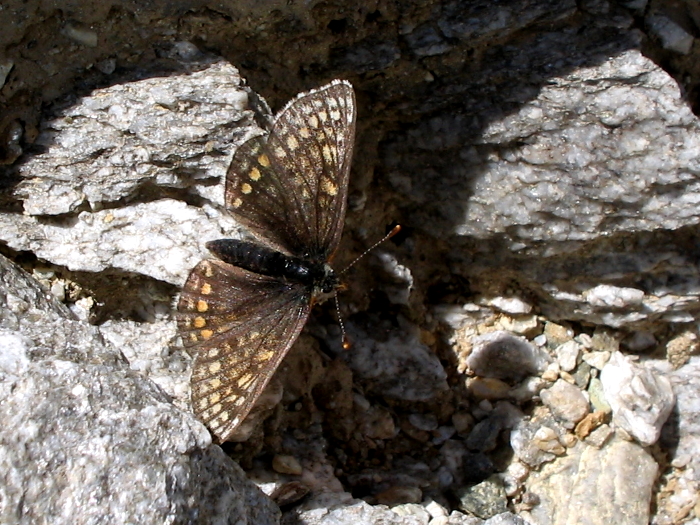I got up at 05h45 this morning and checked the weather forecasts for various places. The winner was Domodossola (in Italy), where I head in summer for Hungarian gliders and large chequered skippers. It's actually getting late for the gliders - a factor that influenced me. But I wished I'd decided and got up earlier! It is an 11km uphill cycle ride from Domodossola to my traditional site, of which 6km is 9% slope and seriously hot work in late morning with 10kg of dog, beer, water and camera in the backpack! I wondered, as I often do, how many more years of this I have left.
As I approached the top of the climb I spotted two Hungarian gliders cruising along by the side of the road. I didn't stop, though, as they didn't look as if they were going to settle anywhere. It was a good sign - they're still on the wing. When I reached the site and let Minnie out of the backpack, there was another good sign - a gravid, female large chequered skipper in the grass. You can tell gravid females because they can't bounce so high. Fresh males look like kids on pogo sticks. Gravid females look more like hippos on pogo sticks. She was down in the grass and I didn't chase her, but got this record shot:

I was to see three more of this species in total - all female so far as I could see. Here is another of them, who also spent her time down in the vegetation:

And the evidence she is a gravid female:

As for the gliders: I never saw a single one stop! It was hot - far too hot for Minnie - and the half dozen I saw were simply gliding, gliding, gliding. I wasn't disappointed - it is a wonderful thing to watch and I have photos I've taken in the past. I did go for a proof shot, though, pointing the camera at a butterfly in flight and hoping for the best. This is a heavy crop of one of the pictures:

Identifiably a Hungarian glider!
I took Minnie down to the river, where we usually see lots of gliders, but only saw one there. It was much more overgrown than previously. Minnie was glad of the water to cool down in, though:


A nice bonus, back on the track above the river, was this fresh, male purple emperor:


Other species at this site included great sooty satyr, silver-washed fritillary, dark green fritillary, heath fritillary, spotted fritillary and a few Lycaenids. This is a purple-shot copper:

We next headed back down the hill - much easier and more fun than cycling up it! - to a site I had found with Kip some years ago, where Hungarian gliders flew. This too was more overgrown than then, though the foodplant was abundant and I'm sure the butterfly is still there. I didn't see it.
Heading down further still, I visited a site near Domodossola where I have seen many good species in the past. By this time it was very hot and Minnie was wilting:

There were lots of fritillaries at this site, including at least silver-washed, spotted, marbled and Queen of Spain. But none stopped, not even for a second, and I didn't have my net. There were definitely other species flying - medium-sized, orange fritillaries, like Niobe or high brown, as well as slightly smaller ones, but everything was zooming at such high speed in the heat I couldn't confirm anything else. I did photograph a reasonably amenable chequered blue here ...

... and an equally amenable small copper:

We then headed down to Domodossola itself, as the weather started to turn. I took Minnie to a river spot so she could drink and cool off a bit as the clouds gathered:


Then back to the station and home to Switzerland. My Swiss travelcard, which gives me unlimited travel in Switzerland, goes as far as Domodossola, so, today's little excursion - successful excursion - cost nothing at all.
Guy




















































































































